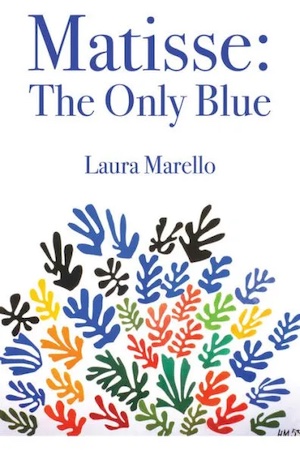By Indira Ganesan
“A pot of paint has been flung on the face of the public,” cried a critic after seeing an exhibit of new paintings in 1905, but what a fine pot it was! Greens and blues and red, and that was just in the face of Madame Matisse as painted by her husband in that exhibit. Laura Marello tells us more: “Woman with a Hat slashed at its first exhibit. 1905. Suddenly you are Fauves. You, who hated naming, have been named.”
Thus, we enter the world of Henri Matisse, as presented in this enchanting, luminous book. We meet Gertrude Stein, who buys his paintings, but decides she prefers Picasso, and seeks to snub Matisse by serving him simple scrambled eggs while Picasso gets elegant omelets. We meet Matisse’s wife, Amelie, who models for him, and keeps house, only to lose him to various models with whom he has seemingly chaste relationships. We meet his extraordinary daughter Marguerite, who becomes a fighter in the Resistance and survives torture by the Nazis, and his son Pierre, who buys a Bugatti to celebrate a successful show of his father’s work in his New York gallery. And we meet Matisse, as he paints and paints, in Nice, and elsewhere, in his studio, his remarkable paintings that “make you want to lie on the beach in the sun, make you want to lie with a woman on a bed, with the second story window open, with the sun and air coming in, the sounds of people arguing on the street below . . . .”
Marello describes the paintings (“So many girls, all of them possessed of something . . . ”) and the colors, addressing Matisse, and addressing us, the viewer. We strain to see what Matisse might have seen, how he sees the blue, the fishbowl, the bathers, the dancers. “You want to strip to the essentials,” Marello writes, “Find the essence.” It is a quest that begins in 1905 in this book of prose poems, going to 1954, through both World Wars, flying from painting to painting, but hovering mostly in Nice.
I found myself looking up various works, to see the image that Marello describes so well, for she too is trying to get to the essence, the essential contained in the frame. I wished this marvelous book came with a tiny flip-it companion of art works, a binder of paintings I could flick through as I read. Lucky is the reader who has just seen one of the recent Matisse exhibits at MoMA or the Boston MFA. We meet Picasso, Bonnard, Renoir, and we meet the models: Amelie, Olga, Lorette, Antoinette, and Lydia. They all have stories, presence, a vibrancy that lets us see why Matisse loved to paint them, and why we look at them, see what is painted: “seated woman, arms spread out along the green and mustard divan, in white neck beads, a white and gray floral blouse, the same moss green pants, the same vase, but red and white, the flowers all yellow, the oranges apples, the lemon still lemon . . . .” I have this image as a screensaver, I realize with a start; how familiar she is, how transformative.
I think you will love this book because while its subject is Matisse and his art, it is also about seeing, and about creating. It is about how the artist struggles to translate what he sees, and how the viewer struggles to align what she sees in front of her with all the stories, all the colors. It is a journey into a life, but a life of which we can never know everything. That mystery is what Laura Marello celebrates, what she holds dear, and what she asks us to see.
Novelist Indira Ganesan was inducted into Phi Beta Kappa at Vassar College. Her books include The Journey (Alfred A. Knopf, 1990), Inheritance (Alfred A. Knopf, 1998) and As Sweet As Honey (Alfred A. Knopf, 2013).




